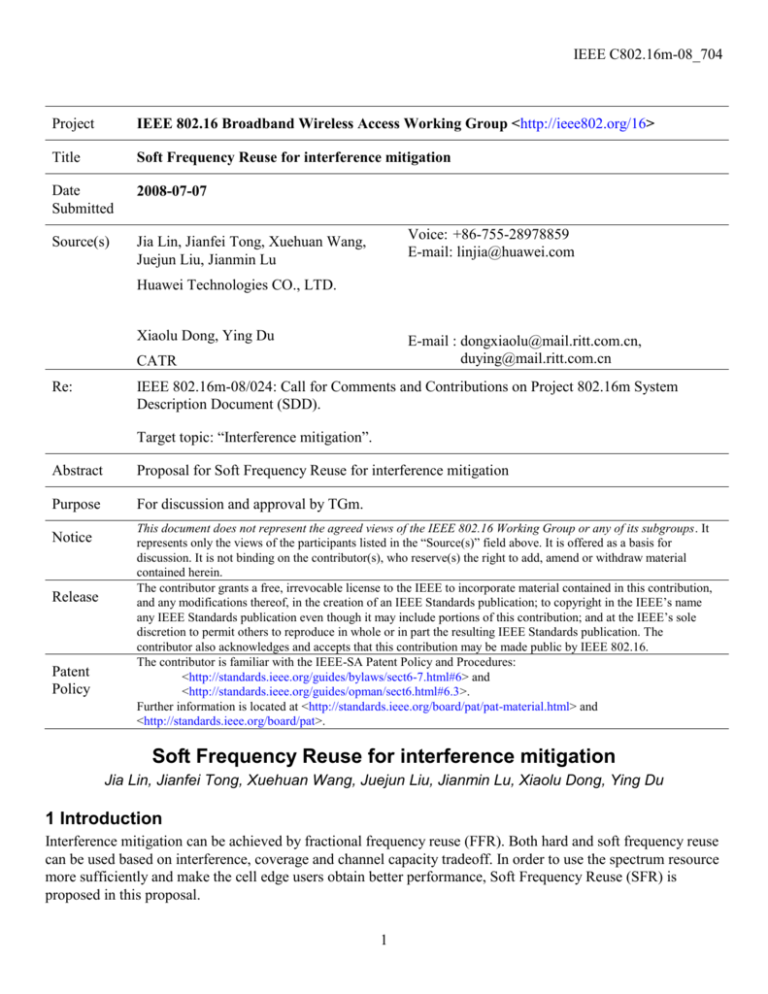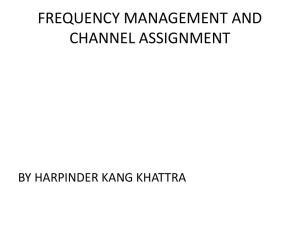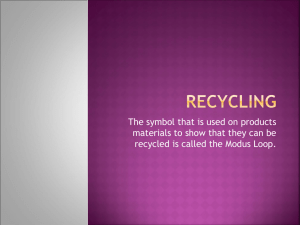3 Fractional Frequency reuse factor
advertisement

IEEE C802.16m-08_704 Project IEEE 802.16 Broadband Wireless Access Working Group <http://ieee802.org/16> Title Soft Frequency Reuse for interference mitigation Date Submitted 2008-07-07 Source(s) Jia Lin, Jianfei Tong, Xuehuan Wang, Juejun Liu, Jianmin Lu Voice: +86-755-28978859 E-mail: linjia@huawei.com Huawei Technologies CO., LTD. Xiaolu Dong, Ying Du E-mail : dongxiaolu@mail.ritt.com.cn, duying@mail.ritt.com.cn CATR Re: IEEE 802.16m-08/024: Call for Comments and Contributions on Project 802.16m System Description Document (SDD). Target topic: “Interference mitigation”. Abstract Proposal for Soft Frequency Reuse for interference mitigation Purpose For discussion and approval by TGm. Notice Release Patent Policy This document does not represent the agreed views of the IEEE 802.16 Working Group or any of its subgroups. It represents only the views of the participants listed in the “Source(s)” field above. It is offered as a basis for discussion. It is not binding on the contributor(s), who reserve(s) the right to add, amend or withdraw material contained herein. The contributor grants a free, irrevocable license to the IEEE to incorporate material contained in this contribution, and any modifications thereof, in the creation of an IEEE Standards publication; to copyright in the IEEE’s name any IEEE Standards publication even though it may include portions of this contribution; and at the IEEE’s sole discretion to permit others to reproduce in whole or in part the resulting IEEE Standards publication. The contributor also acknowledges and accepts that this contribution may be made public by IEEE 802.16. The contributor is familiar with the IEEE-SA Patent Policy and Procedures: <http://standards.ieee.org/guides/bylaws/sect6-7.html#6> and <http://standards.ieee.org/guides/opman/sect6.html#6.3>. Further information is located at <http://standards.ieee.org/board/pat/pat-material.html> and <http://standards.ieee.org/board/pat>. Soft Frequency Reuse for interference mitigation Jia Lin, Jianfei Tong, Xuehuan Wang, Juejun Liu, Jianmin Lu, Xiaolu Dong, Ying Du 1 Introduction Interference mitigation can be achieved by fractional frequency reuse (FFR). Both hard and soft frequency reuse can be used based on interference, coverage and channel capacity tradeoff. In order to use the spectrum resource more sufficiently and make the cell edge users obtain better performance, Soft Frequency Reuse (SFR) is proposed in this proposal. 1 IEEE C802.16m-08_704 Based on SFR, the basis of mitigating inter-cell interference is to classify the users into cell-edge users and cellcenter users according to their geometry factor, and the threshold of the geometry factor can be determined by actual traffic distribution in the cell. 2 Design Consideration and Feature In order to achieve interference mitigation, Soft frequency reuse is introduced in this proposal. Some features should be considered: 1) Frequency reuse factor selection 2) Soft frequency reuse scheme 3) Power level setting for frequency partition 4) Resource planning/coordination 3 Fractional Frequency reuse factor As the figure 1 and 2 shown, analysis of simulation for FFR in cell edge is as below: 2. 3. 4. 5. The smaller the frequency reuse factor, the larger bandwidth can be used in each cell. However, since there is more serious inter-cell interference, SIR will be smaller. In the case of reuse factor is 1 or 2, due to different cells share same frequency resource, each cell has intercell interference from the adjacent cell, which causes SIR lower. In the case of reuse factor is 3, due to the elimination of inter-cell interference from the adjacent cell, there is an obvious improvement to the SIR at the cell edge. With the increasing of reuse factor, the interference will decrease, that result in SIR grows up. However, increment of channel capacity which is caused by SIR growing up can’t compensate loss of bandwidth reduction. After the reuse factor exceeds 3, the channel capacity at the cell edge decrease at a relatively slow rate, and remain above the channel capacity of reuse factor 1 and 2. However, higher reuse factor leads to a low intercell interference and high SIR. It means the noise-resistant capability is poor. The unpredictable noise, such as environment noise will result in a sharp decrease in the SIR and channel capacity. Cell edge SIR (dB) 1. 14 12 10 8 6 4 2 0 -2 -4 -6 1 2 3 4 5 reuse factor Figure 1: SIR of cell edge changed with reuse factor 2 6 7 Cell edge channel capacity (Mbps) IEEE C802.16m-08_704 20 15 10 5 0 1 2 3 4 5 6 7 reuse factor Figure 2: Cell edge channel capacity changed with reuse factor 4 Soft Frequency Reuse scheme The analysis of above shows that inter-cell interference at the cell edge is greatly reduced through frequency reuse factor increasing, which improves the channel capacity. When the MS is in the center of cell, the received power of the wanted user signal is strong, and the interferences from other cells are weak. Therefore, in the cell center, all the sub-carriers can be used to achieve high data rate communication. The soft frequency reuse scheme is characterized by frequency reuse factor 1 in the central region of a cell, and by frequency reuse factor greater than 1 at cell edge region. In this contribution, we propose that reuse factor 3 is used in cell edge and reuse factor 1 is used in cell center. As the figure 3 shown, sector 1 uses resource of group 1 for users in cell edge, while sector 2 and 3 use group 2 and 3 for users in cell edge, respectively. For each cell, all frequency subcarriers can be used in cell center. 3 IEEE C802.16m-08_704 1 2,3 1,3 1 2 1 1,2 2,3 1,3 2 1,3 2,3 3 1 2 1,2 1,2 2,3 3 3 1,3 1 2 1 1,2 1,3 2,3 3 2 2,3 1 2 1,2 3 1,3 sector 1 1,2 2,3 1,3 3 2 sector 2 sector 3 1,2 3 Figure 3: Soft frequency reuse in cluster Frequency factor is 3 in the cell edge, which means that only one frequency fraction can be used for cell-edge users. Meanwhile, all frequency fractions can be used for cell-center users in each cell. All subcarriers are divided into multiple FFR groups (frequency partitions). Each sector can select one or more FFR groups for cell-edge users in terms of reuse factor setting. All groups are used for cell-center users to gain better throughput. Because ranges of covering for different FFR group is different, power level for each group is set below a predefined threshold. As the figure shown, resource of each group is orthogonal each other for decreasing inter-cell interference. Power level of resource for cell edge is always higher than power level of resource for cell center. 4 IEEE C802.16m-08_704 b- s Su rier r ca r we po MS 22 BS 1 subcarr ier MS 12 MS 21 Pow BS 2 ity ns e d er d e MS 11 nsity Po MS 31 en rd we y sit s ca ubrri er MS 32 BS 3 Figure 4: Power level for different groups in different cells In the above figure 4, mobile station 11 and 12 are linked to BS 1, mobile station 21 and 22 are linked to BS 2, and mobile station 31 and 32 are linked to BS 3. Mobile station 11, 21 and 31 are located at the intersection of 3 cells, which means Mobile station 11, 21 and 31 are cell-edge users. Mobile station 12, 22 and 32 are at the inner part of their respective cells, which are cell-center users. For the mobile station at the cell edge, different sub-carriers are allocated to them to avoid the inter-cell interference. For the mobile stations in the cell center, all the sub-carriers can be allocated to them to achieve high data rate. For soft frequency reuse, the low power subcarriers can be scheduled for users at or close to the cell centre. The high power subcarriers can be scheduled for either cell edge or cell centre users. Power Ratio of subcarriers for cell-edge users and subcarriers for cell-center users can be different. The so called “power ratio” is the ratio between transmit power limitation of cell-edge subcarrier and cell-center subcarrier. 4.1 Static mode Frequency reuse pattern and frequency reuse factor are fixed in static mode, the same as power level for different FFR groups in the same cell. 5 IEEE C802.16m-08_704 Size and location of frequency resource for each group are predefined, the same as frequency factor. Each sector allocates fixed resource for its users. And these parameters will not be changed. No signaling is exchanged between BS and MS. But throughput is limited. 4.2 Semi-static mode Frequency reuse pattern and reuse factor is fixed in semi-static mode, but power level for different FFR groups can be changed according to requirement for coverage, channel capacity and received interference. Each cell can switch its FFR groups for cell-edge users in periodic or non-periodic. All subcarriers are divided into multiple groups in terms of predefined Frequency reuse pattern and reuse factor. Each sector can select one or more FFR groups for cell-edge users in terms of reuse factor. The selected FFR groups for cell-edge users can be changed in time domain. As the figure 5 shown, each sector can utilize different FFR groups in different sub-frame/frame/super-frame, all resource can be allocated to users in each sector in time domain, which can get more diversity gain. Frequency 9 8 7 6 sector 1 5 sector 2 4 sector 3 3 2 1 1 2 3 Time Figure 5: The selected resource for each group can be switched in time domain Power ratio between subcarriers for cell-edge and cell-center may be not fixed. BS can negotiate with its neighbor BSs to change its power level for cell-edge and cell-center 4.3 Dynamic mode Frequency reuse pattern and frequency reuse factor are not fixed in dynamic mode, the same as power level for different FFR groups in the same cell. It means that it can change Frequency reuse pattern and frequency reuse factor for each cell. BS collects all users’ feedback information. BS will negotiate with its neighbor BSs to select suitable Frequency reuse pattern and frequency reuse factor according to its users’ feedback information, which is aim to achieve less interference and better throughput. 6 IEEE C802.16m-08_704 In this scheme, due to achieving load balancing in different cells, throughput can be maximized. But it needs more overhead of signaling. 5 Conclusions The combination of the frequency reuse factor 1 in the inner part of a cell, and the frequency reuse factor more than 1 at the outer ring of the cell, called soft frequency reuse scheme, is shown to improve both spectrum efficiency and the cell edge data rate in 802.16m system. In this contribution, three modes are introduced and discussed in soft frequency reuse scheme, which are static mode, semi-static mode and dynamic mode. For soft frequency reuse, Frequency reuse pattern and frequency reuse factor may be changed according to requirement for coverage, channel capacity and received interference. The low power subcarriers can be scheduled for users at or close to the cell centre. The high power subcarriers can be scheduled for either cell edge or cell centre users. Power Ratio of subcarriers for cell-edge users and subcarriers for cell-center users can be different. Insert the following text into Chapter 11 in IEEE802.16m: 7 IEEE C802.16m-08_704 ------------------------------------------- Start of Proposed SDD Text -------------------------------------------------------- 11.X Interference mitigation 11.X.1 Soft frequency reuse for interference mitigation To use the spectrum resource more sufficiently and make the users obtain better performance through interference mitigation, Soft Frequency Reuse (SFR) can be used for interference mitigation in 802.16m. Based on SFR, the basis of mitigating inter-cell interference through resource planning/coordination is to classify the users into cell-edge users and cell-center users according to their geometry factor, and the threshold of the geometry factor can be determined by actual traffic distribution in the cell. For soft frequency reuse, Frequency reuse pattern and frequency reuse factor may be changed according to requirement for coverage, channel capacity and received interference. The low power subcarriers can be scheduled for users at or close to the cell centre. The high power subcarriers can be scheduled for either cell edge or cell centre users. Power Ratio of subcarriers for cell-edge users and subcarriers for cell-center users can be different. ------------------------------------------- End of Proposed SDD Text -------------------------------------------------------- 8







